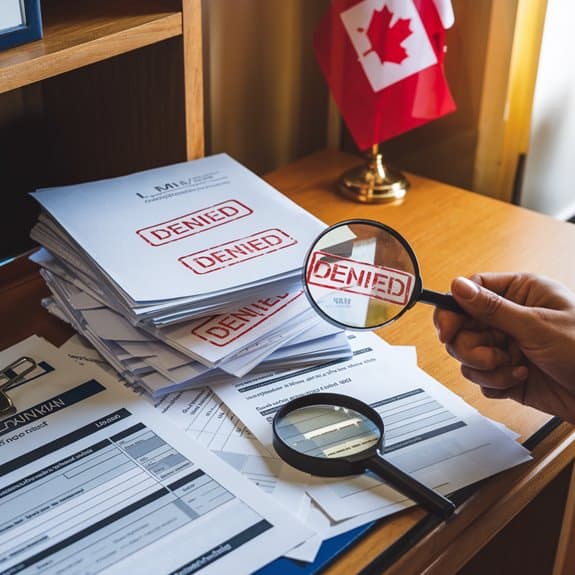
When facing an LMIA-based work permit refusal, you’ll need to carefully analyze your refusal letter to identify specific reasons for denial. Start by gathering documentation that addresses each concern, including updated LMIA confirmation, job offer details, and qualification proof. Consider consulting an immigration professional to help strengthen your reapplication package and guarantee compliance with all requirements. A systematic approach to addressing the refusal points will enhance your chances of approval.
Understanding Common Refusal Reasons
When applying for an LMIA-based work permit, you’ll need to understand several common reasons why applications get refused.
Immigration officers often reject applications due to incomplete documentation, inconsistencies between the LMIA and work permit details, or failure to meet basic eligibility requirements.
Missing documents or mismatched LMIA details are common roadblocks that can quickly derail your work permit application.
You might face rejection if you can’t demonstrate sufficient language skills, qualifications, or relevant work experience for the position.
Immigration officers also scrutinize your intent to leave Canada after your work permit expires. They’ll examine whether your job offer is genuine and if there’s a clear benefit to Canada’s labour market.
Previous immigration violations, criminal records, or concerns about public safety can also lead to refusal.
Additionally, if you don’t provide adequate proof of funds or fail your medical exam, your application may be denied.
Analyzing Your Refusal Letter
After receiving a work permit refusal, your first step should be a careful examination of the refusal letter. This document contains essential information about why your application wasn’t successful and what specific concerns the immigration officer identified.
You’ll need to review each reason listed in the refusal letter and gather evidence that directly addresses these points. Pay close attention to any mentions of missing documentation, inconsistencies in your application, or concerns about your qualifications.
Make a note of the specific sections of law or regulations cited in the letter, as they’ll help you understand the legal basis for the refusal. If you’re unsure about any terminology or requirements mentioned, it’s important to consult an immigration professional who can clarify these points and guide your next steps.
Key Documentation Requirements
Successfully addressing a work permit refusal requires you to compile thorough documentation that directly responds to the concerns outlined in your refusal letter.
You’ll need to gather updated evidence that proves you meet all eligibility requirements and addresses any specific issues raised by immigration officials.
- Employment Documentation
- Valid job offer letter with detailed terms
- Updated LMIA confirmation
- Proof of required qualifications and experience
- Personal Documentation
- Valid passport
- Updated medical exam results
- Police clearance certificates
- Supporting Evidence
- Detailed explanation letter addressing refusal grounds
- Proof of continued recruitment efforts
- Evidence of maintained relationship with employer
Remember to organize your documents systematically and include a clear index to help officials quickly locate relevant information during their review.
Strategic Steps for Reapplication
With your documentation properly organized, taking strategic action on your reapplication can considerably improve your chances of approval.
You’ll need to carefully address each point of refusal in your new submission, providing additional evidence where necessary.
Start by drafting a detailed response letter that systematically addresses every concern raised in the refusal notice.
You should include any new supporting documents that strengthen your case, such as updated employment contracts or revised job descriptions.
If you’ve made changes to meet specific requirements, highlight these adjustments clearly.
Consider adding a legal submission from an immigration lawyer to bolster your application’s credibility.
It’s also essential to double-check that your LMIA remains valid throughout the reapplication process, as expired LMIAs will require a fresh start.
Legal Options and Federal Court Review
Should your LMIA-based work permit application face rejection, you’ll need to understand your legal recourse options, particularly regarding Federal Court review.
This process allows you to challenge the immigration officer’s decision if you believe it was unreasonable or procedurally unfair.
- You must file your application for judicial review within 15 days of receiving your refusal.
- You’ll need to demonstrate that the officer made an error in law or failed to assess important evidence.
- The court won’t make a new decision but can send your case back for reconsideration by a different officer.
Working with an experienced immigration lawyer is essential during this process, as they’ll help you identify grounds for review, prepare legal submissions, and represent you effectively in Federal Court proceedings.
Addressing Eligibility Concerns
When immigration officers review LMIA-based work permit applications, they’ll carefully assess your eligibility against several key criteria that can make or break your application. You’ll need to demonstrate that you meet all requirements and address any potential concerns proactively to strengthen your case.
| Eligibility Criteria | Required Evidence |
|---|---|
| Work Experience | Detailed resume, reference letters |
| Education | Diplomas, certificates, credentials evaluation |
| Language Proficiency | IELTS or TEF test results |
| Financial Capacity | Bank statements, proof of funds |
| Genuine Job Offer | Employment contract, LMIA documents |
Double-check that your qualifications match the job requirements exactly as stated in your LMIA. Immigration officers will look for discrepancies between your credentials and the position’s requirements, so ascertain everything aligns perfectly with both the LMIA and employer’s expectations.
Building a Stronger Application Package
To strengthen your LMIA-based work permit application, you’ll need to assemble a thorough package that addresses every potential concern an immigration officer might raise. Your documentation should clearly demonstrate your qualifications, work experience, and intention to comply with Canadian immigration laws.
- Include a detailed cover letter explaining how you meet all eligibility requirements, addressing any previous concerns, and providing context for your application.
- Submit updated supporting documents, including employment contracts, educational credentials, and professional certifications with certified translations.
- Provide extensive evidence of your ties to your home country, such as property ownership, family relationships, or business interests.
Remember to organize your documents logically, with a table of contents that makes it easy for officers to review your application efficiently and thoroughly.
Working With Immigration Professionals
Partnering with qualified immigration professionals can greatly improve your chances of success with an LMIA-based work permit application.
At Canadian Currents Immigration Services, you’ll work with a team of lawyers, consultants, and paralegals who’ve decades of combined experience in immigration law. They’ll provide tailored guidance specific to your situation.
These professionals will help you navigate complex immigration requirements, guarantee your documentation is complete and accurate, and craft strong responses to any concerns raised in your refusal letter.
They’ll also represent you effectively if your case needs to go to Federal Court. Working with experts who understand the intricacies of immigration law reduces errors and strengthens your application, giving you the best possible chance at a successful outcome.
Maintaining LMIA Compliance Standards
Once you’ve obtained your LMIA-based work permit, it’s crucial to maintain strict compliance with all standards and regulations throughout your employment period.
You’ll need to guarantee your work activities align with the terms specified in your LMIA and work permit, including job duties, location, and employer details. Any changes to these conditions may require a new application or amendment.
- Document all employment activities, hours worked, and wages received to demonstrate compliance with labour standards.
- Maintain regular communication with your employer about any workplace changes that might affect your LMIA conditions.
- Keep records of professional development and training activities that align with your approved position.
Understanding and following these compliance requirements will help protect your immigration status and support future applications or renewals.
Stay informed about any updates to regulations that might affect your work permit conditions.
Frequently Asked Questions
Can I Continue Working While My Lmia-Based Work Permit Refusal Is Under Review?
You can’t legally work while your LMIA-based work permit refusal is under review. You must wait for a decision or new permit before resuming work to avoid immigration violations.
How Does an Employer’s Bankruptcy Affect My LMIA Refusal Appeal Process?
Your employer’s bankruptcy can greatly impact your LMIA appeal since you’ll need a valid job offer. You should seek legal counsel and consider finding a new employer with a fresh LMIA application.
Are Processing Times Different for Refusal Reviews in Various Canadian Provinces?
While processing times can vary slightly by province, your federal court review of an LMIA refusal follows national standards. You’ll typically wait 3-6 months regardless of your location.
Can Family Members Remain in Canada During My Work Permit Refusal Review?
Your family members can stay in Canada if they have valid status, but they’ll need to maintain or extend their permits independently while you undergo the review process.
What Happens to My LMIA Approval if I Change Employers During Review?
Your LMIA approval is employer-specific and won’t transfer to a new employer. You’ll need to obtain a new LMIA if you change employers during your work permit review process.
Conclusion
When you’re dealing with an LMIA-based work permit refusal, you’ll need to act quickly and strategically. Review your refusal letter thoroughly, gather strong supporting documentation, and consider professional legal assistance to strengthen your case. Whether you choose to reapply or pursue a Federal Court review, make certain you’ve addressed all cited concerns. By taking methodical steps and maintaining compliance standards, you’ll maximize your chances of a successful outcome.

We serve ALL of Canada. Currently have offices Western Canada — Vancouver, Calgary, Edmonton, Kamloops and Red Deer. We also have the infrastructure to work with any of our clients virtually — even from the furthest regions of the Yukon to Newfoundland.
Call (778) 331-1164 [toll free 1 (844) 715-0940] to get routed to the best office for you or contact us online to schedule an appointment.
We also have a dedicated intake form to help you get the ball rolling. Our intake team will review your specific case and advise you on the next steps to take as well as what to expect moving forward.
Our offices are generally open 8:30 a.m.—4:30 p.m., Mon—Fri.

Shantale D’Aoust
IMMIGRATION LAWYER
Shantale has vast advocacy experience, and she strives to help her clients navigate through their legal issues by assessing risks to provide practical options and tailored solutions to their unique legal matter. Her core areas of practice include permanent residence and temporary residence applications and appeals, and matters involving the interplay between immigration laws and family law issues.



